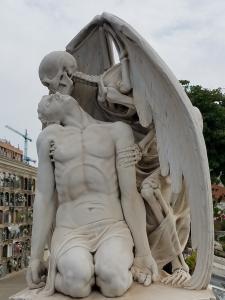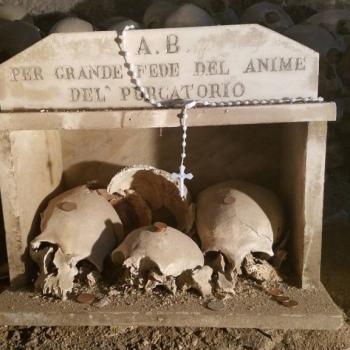
This piece was supposed to be about the Virgin of Montserrat, the Black Matroness of Catalonia whose majestic shrine I visited last week. But just as Mexican skeleton saint, Santa Muerte, seduced me into contemplating her instead of the Virgin of Guadalupe, the ‘Kiss of Death’ diverted my attention away from the Black Madonna. El Petó de la Mort (Kiss of Death in Catalan) is a stunningly gorgeous marble statue of a winged skeletal Angel of Death embracing and kissing an Adonis whose ripped physique recalls the impressive statue of the Mormon Jesus (Christus) I saw a few yeas ago in Salt Lake City.
That thanatological interests would lead me away from the intriguing Matroness of Catalonia is actually of little surprise given my research focus over the past decade. Having spent nine years researching the Mexican folk saint of death, I am now commencing a new book project on Catholic memento mori in Europe and the Americas. Thus cemeteries, ossuaries, incorruptible bodies of saints, holy relics, and the Grim Reaper and Reapress are the current objects of my research desire. And recently being in Barcelona for the Latin American Studies Association conference one of my greatest desires in the Catalonian capital was to view with my own eyes the hauntingly beautiful sculpture that I’d seen so many times in digital form posted on Twitter by partisans of the Death Positive movement.
At Poblenou, Barcelona’s oldest cemetery, the main attraction is the exquisitely detailed sculpture, which evoked a cascade of emotions and reflections. Perhaps most striking is the eros of the scene in which the Angel of Death holds the moribund male in a lover’s embrace giving him the tender kiss that delivers him to the celestial realm. The marble obra maestra was created in 1930 when Spain was still one of the most Catholic countries on earth so the great majority of the thousands of souls interred at Poblenou would have subscribed to Christian notions of the afterlife. Of course the connection between thanatos and eros is a long established one in the West, which is captured perfectly in the French phrase ‘la petite mort’ or little death, denoting the otherworldly ecstasy often felt during orgasm. Moreover, there has historically been sufficient interest in corpses as objects of sexual desire, at least on the part of some men, that there is even a word of Greek origin for it – necrophilia (literally “love of the dead”).
But the eros of El Petó de la Mort is imbued with the sweetness of lovers whose passionate embrace transcends the carnal eroticism of casual partners. Here the tenderness of death, sans eroticism, recalls St. Francis’s notion of death as a ‘sweet sister.’
All praise be yours, my Lord, All praise be yours, my Lord,
for our Sister, Physical Death, from whose embrace no mortal can escape.
Woe to those who die in mortal sin!
Happy are those she finds doing your most holy will!
The second death can do no harm to them.
To die with the sacred joy of not having done harm to oneself nor to a single soul.
The erotic romanticism of the Kiss of Death stands in stark contrast the predominant personification of death in the West since the Black Plague of the Medieval era – the Grim Reaper of Britain and his male equivalents in northern Europe and female counterpart in the Mediterranean south, the Grim Reapress (la Parca in Spain and Italy). Cutting a grim figure, the black-robed and hooded Reapress/Reaper comes to unceremoniously slash the cord of life. Her iconic scythe, while a far cry from the automated grain harvesters of today’s corporate farms, reaps human souls with cold efficiency, for there was no time for lingering kisses when the Bubonic Plague was decimating European towns and cities.
Memento mori weighs heavily on me when turbulence hits at 35,000 feet above the ground. Back on terra firma, I am elated at having eluded both the Reaper’s scythe and the Reapress’s kiss as an automated aluminum cylinder hurtled me from Barcelona back across the Atlantic. Memento vitae!













